In this day and age, technology is able to provide its audience an overwhelming amount of content. Every single day, a person is bombarded with news articles, blogs, videos, and the like, just by going online.
However, not all of these are relevant content, others just exist as noise. How do you capture the attention of your audience, especially if you’re up against thousands of pieces of content online? The first step is knowing the basics: follow a specific writing style that works best for you.
The AP Style, which is short for Associated Press Stylebook, is a set of guidelines followed for news writing. It is used in many newspapers, magazines, and public relations in the United States. Being guided by the AP Style will help you write compelling headlines as much as you want it to sound professional and trustworthy. Learn more about this style of writing in this article.
Write Better Headlines With This Trio of Resources and Templates
Put these ten tips into practice with these three resources:
- AP Style Cheat Sheet: Never forget important AP style standards ever again.
- 180+ Emotional Power Words Tear Sheet: Keep this list of emotional words on hand to level up your headlines.
- Editorial Calendar: Plan every piece of content and headline you’ll publish in one place.
Why Use AP Style When Crafting Your Headlines?
Ensures Consistency
Consistency is one of AP Style’s main guiding principles because it makes you follow a set of guidelines that you have to stick to when you write. From abbreviations, acronyms, dates, to numbers, the AP Style has rules for these that you should follow to be consistent in your writing.
Clear and Accurate
Along with consistency, clarity and accuracy are also part of AP Style’s guiding principles. If your writing is clear and easy to understand, then your content will most likely leave a good impression on your audience. Being clear and accurate in your writing can help you in many things, one of which is in crafting good SEO titles.  Your website’s SEO title is what appears on Google results, and it essentially gives your audience an idea what your web page is all about. A great SEO title has the ability to captivate the audience enough for them to visit your website. It has to be short, but make sure you choose specific keywords that help increase your search ranking. Of course, the title is just the tip of the iceberg. The content found on your website should also be clear, accurate, and captivating.
Your website’s SEO title is what appears on Google results, and it essentially gives your audience an idea what your web page is all about. A great SEO title has the ability to captivate the audience enough for them to visit your website. It has to be short, but make sure you choose specific keywords that help increase your search ranking. Of course, the title is just the tip of the iceberg. The content found on your website should also be clear, accurate, and captivating.
Professional-looking Content
Finally, writing in AP Style makes your content look polished and thus, professional. The guidelines include how you phrase and structure your sentences for it to have a professional tone in subtle ways. Even the smallest details matter in writing, so AP Style is there to give your content a fluid structure and tone that is clear to the your audience. 
AP Style Best Practices for Headlines
Now, it’s time to get down to the writing tactics you need to know to ensure your headlines are clear, concise, and easy to read.
Write Your Headline in the Title Case
The most basic thing to take note of is knowing what word to capitalize and not. It may be tempting to capitalize every single word in your headline for it to sound important, but you should not. Only the first letter of the first word of your headline, as well as all first letters of proper nouns, should be in the title case.
Stick to Facts
The Associated Press values their mission to “bring truth to the world”. Thus, it is important for you to focus on the facts, rather than opinions. It takes a good journalist to fact-check before putting everything into writing. Part of learning and perfecting the AP Style is to observe how news websites craft their headlines and articles. You may draw inspiration from how these minority-owned businesses write their content: Blavity and BlackEnterprise.  For example, in the article above, by Blavity, they give us all the important facts to get to know the main content of the article. When the reader lands on this page, they’re taken to a list of different states and cities, complete with the exact details of when each declared a public health crisis in their area.
For example, in the article above, by Blavity, they give us all the important facts to get to know the main content of the article. When the reader lands on this page, they’re taken to a list of different states and cities, complete with the exact details of when each declared a public health crisis in their area.
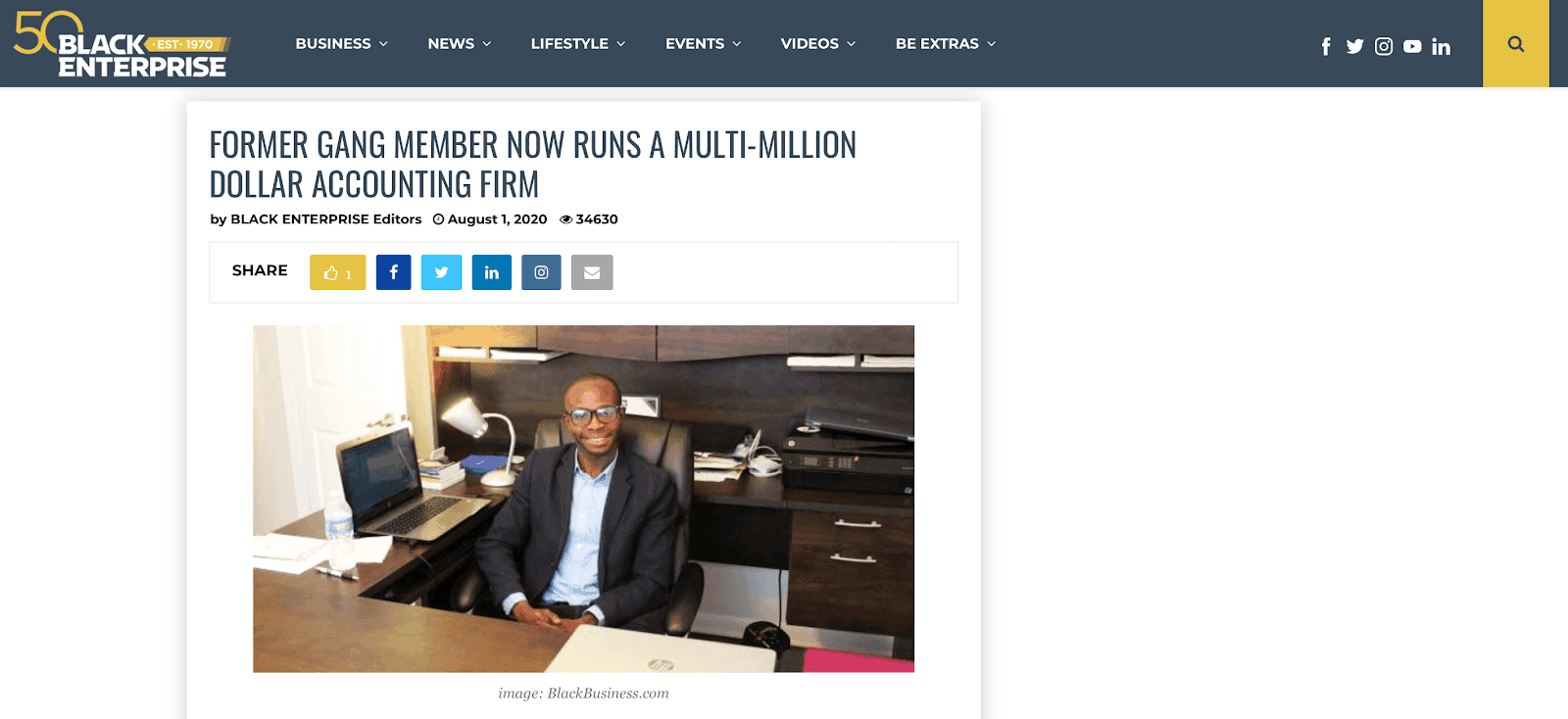 With BlackEnterprise, they show us how to create a compelling, eye-catching headline with a hook — an ex-gang member turned entrepreneur. Their headline doesn’t resort to clickbait, instead presenting the facts straight away and leading the reader to the story of this successful entrepreneur.
With BlackEnterprise, they show us how to create a compelling, eye-catching headline with a hook — an ex-gang member turned entrepreneur. Their headline doesn’t resort to clickbait, instead presenting the facts straight away and leading the reader to the story of this successful entrepreneur.
Use Abbreviations Sparingly
The AP Style has guidelines when using abbreviations. One, use it only for well-known organizations, like the FBI, NASA, and FIFA. Two, abbreviations can be applied to people’s formal titles, such as political and medical titles, like CEO or PhD.
Lastly, every state in the United States has a specific abbreviation for you to follow. It may seem hard to remember what you can abbreviate or not, but you’re welcome to refer to the online AP Stylebook, which has the updated list of which words can be abbreviated. However, seeing a lot of abbreviations in your writing could look messy and confusing to your reader so be sure to use it sparingly. Remember the principle: “When in doubt, spell it out.”

Proper Placement of Punctuation
If you think you’ve already mastered punctuation, think again. The AP Style has quirks that you have to consider. Here are some of the rules to take note of:
- Periods: Use only one space at the end of a period. Lean towards using periods in abbreviations when applicable.
- Serial Commas: Commas are not used before a conjunction in a single series, but they should be used to separate each item on a list.
- Apostrophes: When proper nouns end with an S, just add an apostrophe at the end.
- Colon: Capitalize the first word after a colon but only if it’s a proper noun. Colons are also placed outside quotation marks, unless they are part of the quote.
Correct Spelling for Tech Terms
More and more tech terms are coming out every single day, so be sure that you are writing these correctly in your headline. Some of the common ones you may encounter are the following: 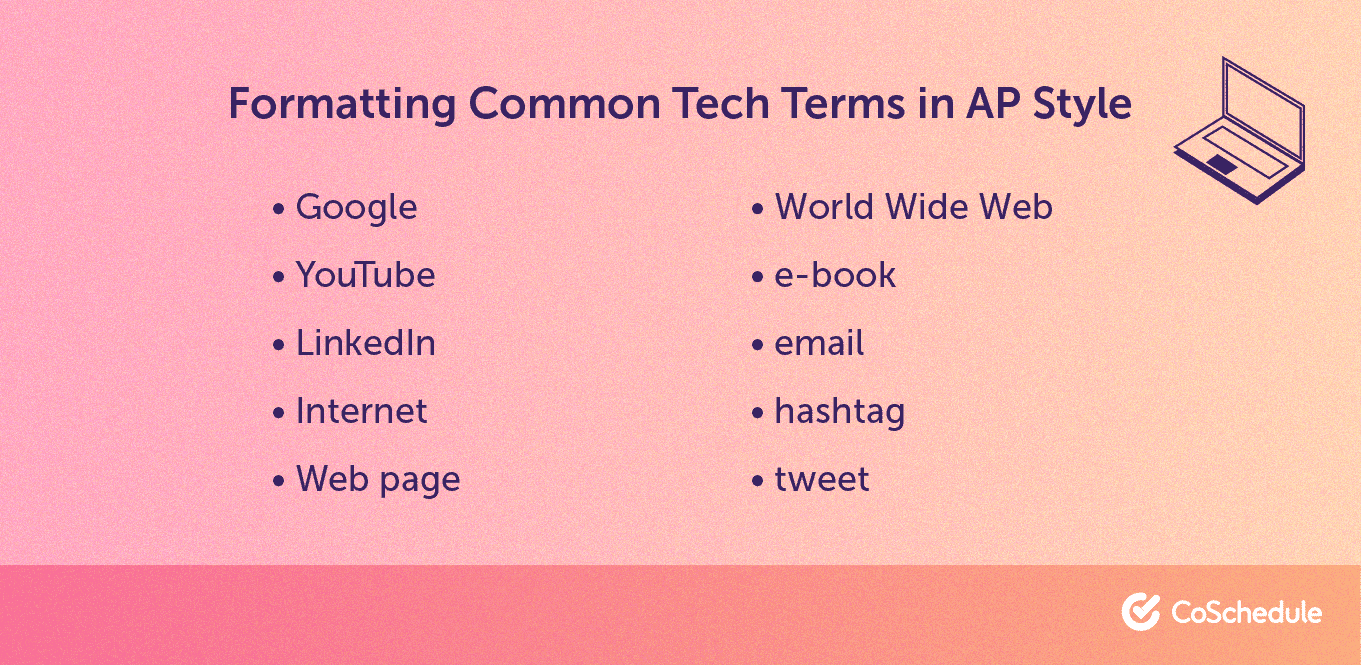 Keep yourself updated on the rules of AP Style for new tech terms that come out so that you can apply it in your headline. You can follow the AP Stylebook Twitter account to get the most updated tips and advice.
Keep yourself updated on the rules of AP Style for new tech terms that come out so that you can apply it in your headline. You can follow the AP Stylebook Twitter account to get the most updated tips and advice.
Write in Active Voice
When writing in active voice, the subject of your sentence is doing the acting. An example would be, “Angelica kicked the ball.” Angelica, the subject, was the one who conducted the action. Active voice is used for non-scientific writing and is generally clearer and easier to understand compared to the passive voice.
Using the active voice makes your sentences crisp or concise, since it only uses a few words compared to following the passive voice. This works best when you want to capture a complete and compelling thought in your headline.
When to Spell Out Numbers
In AP Style, numbers one through nine should typically be spelled out, and digits should be used for numbers 10 and up. However, the following exceptions should always use digits: 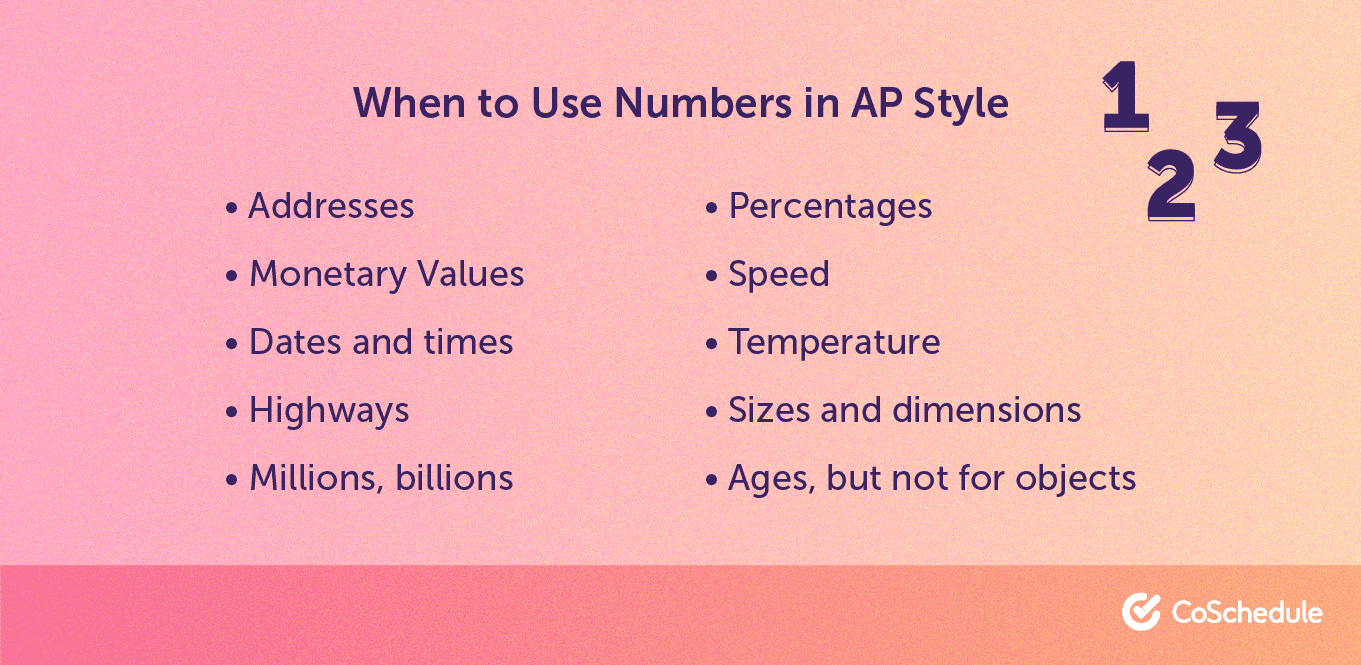
Write Headlines Like a Journalist
Once you have checked out news websites, blogs, and studied how journalists write their headlines, you would notice how skilled they are in crafting catchy and memorable titles, while still sticking to the facts.
If you are someone who owns or writes for an online publication, one of your goals is to increase traffic on your site using the power of the words you sew together in your headline. Thus, your headline should fascinate your readers enough for them to read the whole article. This is what you should aim for: compelling yet factual headlines. Aside from browsing through different news and journalism websites, you can also draw inspiration from online tools, like this slogan generator that only make use of one keyword to craft witty titles.
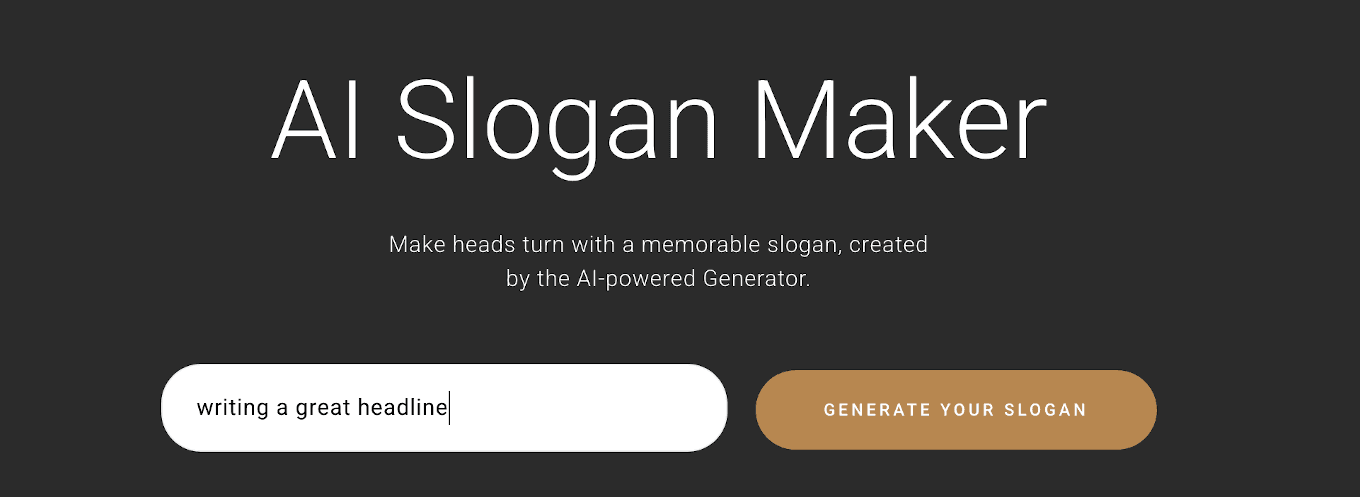
CoSchedule’s Headline Analyzer Studio is another option for optimizing writing headlines. You can then test different variations of your headlines by weighing them against a numerical score and seeing the reason for each result.

K.I.S.S. Your Headlines
K.I.S.S. stands for “Keep It Simple, Stupid,” or in other words, “short and simple”. Part of AP Style’s guidelines is to be concise, so make sure you use just enough words to capture your entire thought. Remember that the global attention span has narrowed, so the shorter and sweeter the title is, the better. For your reference, title tags are kept to 70 characters maximum on Google. Once you find the optimal character length on Google, then it could lead to more click throughs. [Tweet “Keep it simple, Stupid (K.I.S.S.)”]
The Four U’s
Last but not least, make sure you follow the four U’s when you craft your headline.
- Useful: How will this headline benefit the reader? Highlight the benefits that would draw the reader to read your content.
- Urgent: How does this headline compel my reader to act? If possible, provide a time frame in your headline which moves the reader to act before it’s too late. You may also choose to emphasize a need that the reader might need.
- Unique: How does this headline stand out? Surprise the reader with a shocking fact or a distinctive slant that would make them want to read more. As a journalist, learn to criticize your own headline and ask yourself this question: “Does this make me want to read the entire article?”
- Ultra-specific: How does this headline give details to the reader? A good headline goes big on details. Emphasize a specific point that may include numbers, an exclusive piece of information, or a unique slant.
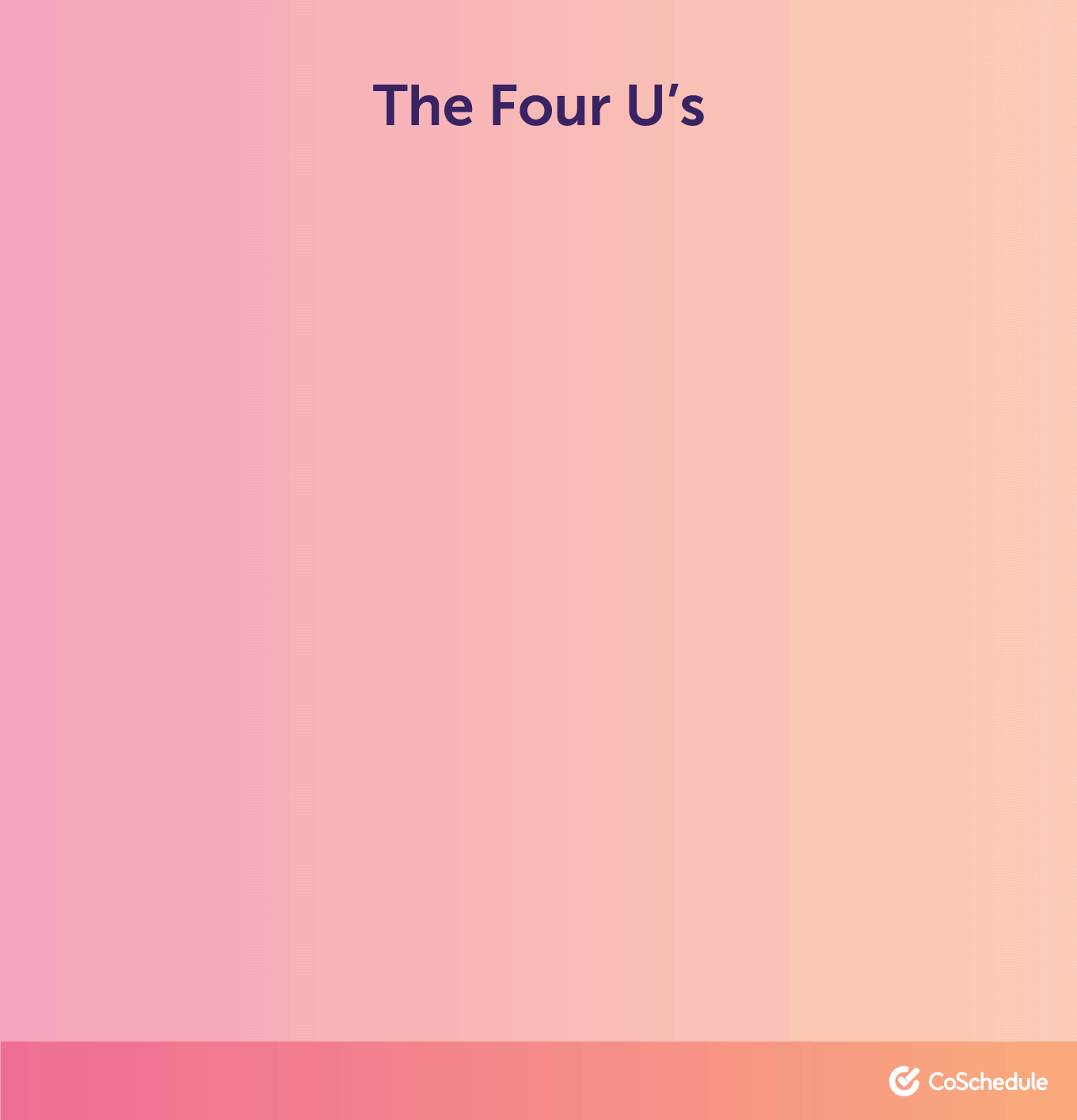 Don’t be afraid to write multiple variations of your main headlines to find the best one that could help achieve your goals.
Don’t be afraid to write multiple variations of your main headlines to find the best one that could help achieve your goals.
Key Takeaways
Content is said to be king, but not all deserve to be “royalty”. Especially today, you have to compete against thousands of content online. First, learn to gain the trust of the market by showing how well you can write and compose relevant content through following a style of writing, such as AP Style. Then, learn from good journalists and listen to your audience — these can help you create headlines worthy to be called “royalty”.
